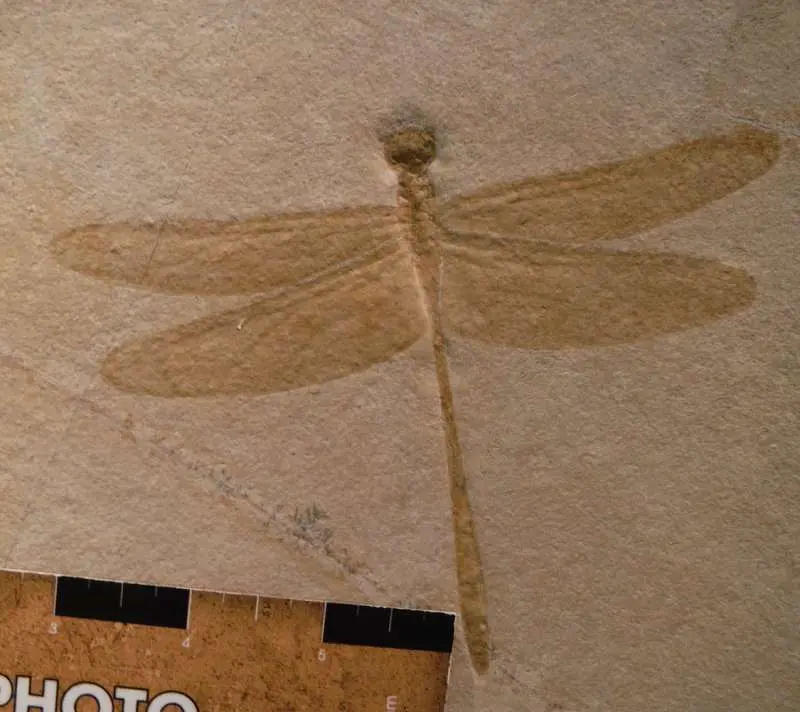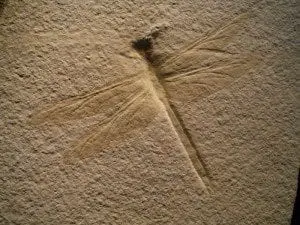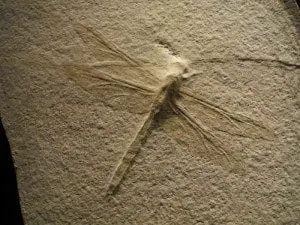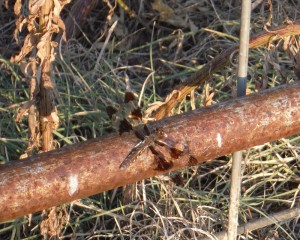
“Hurry! Let’s catch one!” Declared my 5-year old friend, as she ran across the grass, wielding a plastic cup and lid. Swarms of dragonflies were dancing overhead. The girl leaped into the air, spinning and reaching her cup as high as she could, trying to catch a dragonfly and imploring for my assistance. The sun was just starting to sink on that beautiful August evening. I couldn’t imagine a better way to spend an evening than chasing the swarms of dancing dragonflies, and later chasing the best view of the sunset, with my young friend across the wide, open countryside. Though we didn’t actually catch a dragonfly, we enjoyed watching these fantastic flying creatures.
Living dragonflies are amazing, but several weeks ago I also got to see some fossil dragonflies from the German Solnhofen Limestone formation. Last week, we looked at the incredible way jellyfish fossils were preserved in the Solnhofen rock by the rapid, catastrophic burial during Noah’s Flood (read that article here). Just like the soft-body of a jellyfish, dragonflies, with their delicate wings, are very difficult to preserve as fossils. These fossil dragonflies were big, but some are much larger – giant dragonflies that thrived in lush environments before the global flood. Giant fossil dragonflies with wingspans of up to thirty inches have been found in rock layers classified as Pennsylvanian (learn more about rock layer classification here).
One thing that is interesting to notice about dragonfly fossils is how similar they are to the dragonflies we see today. Think about it for a minute. According to evolutionists, the beautifully preserved dragonflies of the Solnhofen lived about 155 million years ago, and giant dragonflies (in Pennsylvanian rock) lived a supposed 325 million years ago. Why is it that dragonflies have stayed basically the same for that long? The issue gets more intriguing as we look at some of the other creatures amazingly preserved in this rock unit. We find shrimp, lobsters, katydids, water striders, beetles, and cockroaches almost exactly like the ones we see today. Perhaps these creatures didn’t evolve after all and didn’t live millions of years ago. The Biblical account of creation and a catastrophic, global flood, just a few thousand years ago seems to line up better with the fossil evidence.
“The insects go through [the event that killed off the dinosaurs] with apparently little change . . . We’re talking about more than cockroaches. We’re talking about butterflies and bees” ~ Dr. William Clemens, professor of integrated biology, University of California, Berkeley
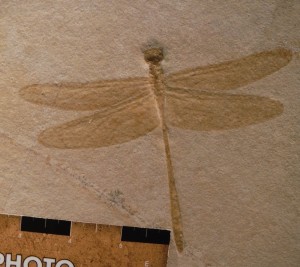
The most famous fossil from the Solnhofen formation is Archaeopteryx, often said to be a “missing link” between birds and dinosaurs. In reality, it is just an extinct type of bird. There are a lot of problems with the idea of dinosaurs-to-birds evolution, but going into all of those is beyond the limits of this article (find previous writings on the topic here). One big issue with dinosaur-to-bird evolution is how all of the right features required for flight could evolve. Looking back to the dragonfly fossils we started with, flying creatures of some kind are found deep in the fossil record. There is a wide variety of flying creatures including birds, bats, dragonflies, and pterodactyls (flying reptiles), all with different designs for flying. If evolution was true, the ability to fly would have to evolve at least three completely unrelated times. The Bible offers a different history of flight. God created sea creatures, like the jellyfish, and flying creatures, like birds and dragonflies, all together on day 5 of creation.
Copyright Sara J. Bruegel, March 2016
References:
- Andy McIntosh. 100 years of airplanes—but these weren’t the first flying machines! Creation Magazine26(1):44–48. December 2003. Creation Ministires International. Last accessed 3/25/16 http://creation.com/100-years-of-airplanesbut-these-werent-the-first-flying-machines
- Localities of the Jurassic:The Solnhofen Limestone of Germany. Introduction to the Odonata:Dragonflies and Damselflies. University of California Museum of Paleontology. Last accessed 3/25/16 http://www.ucmp.berkeley.edu/arthropoda/uniramia/odonatoida.html
- Carboniferous Period. Prehistoric Timeline. National Geographic. Last accessed 3/35/16 http://science.nationalgeographic.com/science/prehistoric-world/carboniferous/
- Carl Werner. Living Fossils. Pages 45-69. 2008. New Leaf Press. Green Forest, AR.

